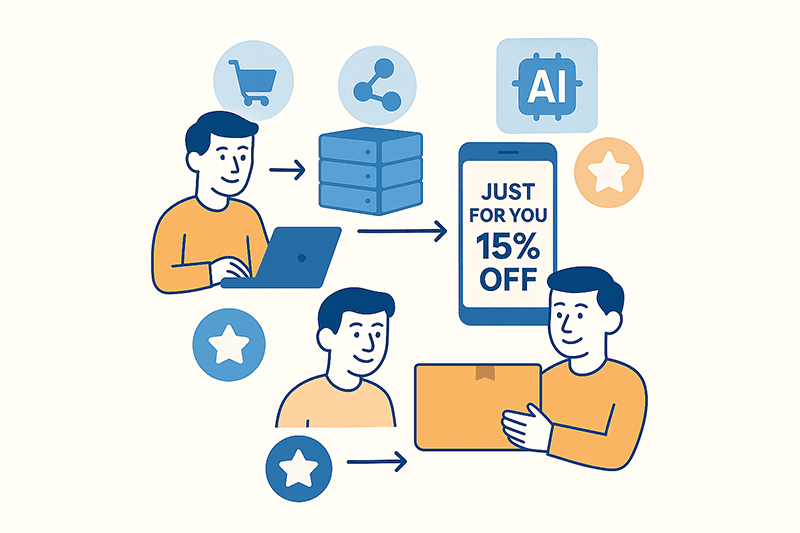Why Personalized Loyalty Programs Are Essential for E-Commerce Brands in 2025

Introduction: Why Traditional Loyalty Programs Are Losing Their Power
E-commerce businesses are pouring resources into loyalty programs—yet many still struggle to increase repeat purchases or build meaningful customer relationships. Why? Because today’s consumers are tired of generic rewards, complicated point systems, and irrelevant offers.
The pain is real:
- Customers forget about loyalty programs after signing up.
- Redemption rates remain low despite rising program costs.
- Brands see churn from even their most “loyal” users.
- Point systems become bloated and feel disconnected from real shopping behaviour.
In a world where buyers expect hyper-personalized Netflix recommendations and one-click Amazon orders, a “one-size-fits-all” loyalty program feels outdated. Customers no longer want to be treated like numbers—they want to be seen, understood, and rewarded in ways that matter to them.
This is where personalised loyalty becomes a game-changer. In today’s competitive e-commerce landscape, personalisation isn’t a bonus—it’s the foundation of customer retention and emotional loyalty.
What Is Personalised Loyalty in E-Commerce?
Personalised loyalty means creating a rewards experience that feels custom-built for each customer. It uses data—like past purchases, browsing behaviour, frequency, and demographics—to deliver targeted offers, reminders, and perks that feel timely and relevant.
Think of it as:
- Offering a birthday reward with the user’s favourite product.
- Sending a "we miss you" email after 30 days of inactivity.
- Recommending reward options based on past categories browsed.
It shifts the conversation from “Here’s your generic reward” to “Hey, we know what you love—here’s something just for you.”
Why Personalization Works (When Traditional Programs Don’t)
1. Higher Engagement Rates
Generic reward programs often lead to email fatigue and disinterest. But when customers receive relevant messages—like a coupon for the exact item they viewed last week—they're far more likely to act.
Stat: Personalised messages can drive up to 80% higher engagement compared to non-targeted ones.
2. Better Retention and Repeat Purchases
When shoppers feel understood, they come back. A brand that remembers what they like, how often they shop, and when they usually reorder earns more than a sale—it earns trust. That trust is what brings them back, even when competitors offer discounts.
3.Emotional Connection (Beyond Points)
Transactional loyalty is shallow—it disappears when someone offers a better deal. Emotional loyalty, however, builds when people feel a brand genuinely gets them. Personalised loyalty creates moments of delight that foster long-term emotional bonds.

The Role of AI and Data: Scaling Personalisation Without Losing the Human Touch. In the past, personalisation was manual and time-consuming. But now, with AI and behavioural analytics, you can personalise at scale—without sacrificing the experience.
Here’s how modern e-commerce brands use AI in loyalty: Recommend products based on past views and purchases. Trigger reminders when a customer leaves an item in the cart. Adjust reward tiers based on engagement or spend history. Send time-based emails (e.g., restock reminders, seasonal discounts).
The result? A loyalty program that evolves in real-time, adapting to the shopper’s behaviour—not the other way around.
Real-World Examples of Personalised Loyalty in Action
Sephora – Beauty Insider Uses purchase data to send personalised product recommendations, gifts, and reminders. Their tailored approach turns cosmetics shopping into a beauty journey.
Starbucks – Starbucks Rewards Learns your drinking habits and sends suggestions (like your usual latte) at your preferred time. The app becomes part of the daily routine.
Amazon Needs no introduction—Amazon’s loyalty doesn’t come from points but from predictive convenience. With machine learning, it offers subscriptions, bundle offers, and reorder nudges tailored to each customer. These companies aren't just giving rewards—they’re giving relevance.
How to Start Building Personalised Loyalty
You don’t need to be a tech giant to implement personalisation. Start with these steps:
- Collect customer data: Email, past orders, engagement patterns.
- Segment your audience: New users, high spenders, inactive customers.
- Create targeted campaigns: Offer welcome rewards, “We miss you” discounts, or refer-a-friend bonuses.
- Use tools with AI capability: Platforms like Reward Rally make personalisation easy for all business sizes.
The Future Is Personal
In the coming years, e-commerce loyalty will be defined by personalisation. Brands that use data and AI to craft tailored, meaningful experiences will win not just transactions—but long-term trust and loyalty. Don’t just reward your customers. Recognize them. Understand them. Grow with them.

